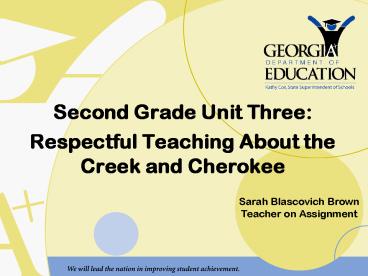Second Grade Unit Three: - PowerPoint PPT Presentation
1 / 14
Title:
Second Grade Unit Three:
Description:
Respectful Teaching About the Creek and Cherokee ... so that they do not view America s original inhabitants as one conglomerated group of Indians. – PowerPoint PPT presentation
Number of Views:99
Avg rating:3.0/5.0
Title: Second Grade Unit Three:
1
- Second Grade Unit Three
- Respectful Teaching About the Creek and Cherokee
Sarah Blascovich Brown Teacher on Assignment
2
Establishing Our Prior Knowledge
?
- What do we know about Georgias first people?
- Describe their culture as it was when Oglethorpe
other English settlers arrived in Georgia. - How do Native Americans maintain their culture
heritage today?
3
Creek Community Life
- Confederation tribal towns were individual
units within it - Covered entirety of Southeastern US at time of
contact - Removed in 1830s via treaty to lands in
present-day Oklahoma - Todays membership 60,000
4
Where the Creek lived in Georgia
- You see that manydifferent treaties and
cessions tookthe land of the Creek over time. - The very first cession, right alongthe Savannah
Riverwas to whom?
5
Cherokee Community Life
New Echota
- Division oflabor betweenmen women
- Active trading culture
- Settled, farming communities
- Removed to Oklahoma in 1838 the Trail of Tears
Cherokee Courthouse - Oklahoma
6
Where the Cherokee Lived in Georgia
map from Carl Vinson Institute, UGA
Cherokee holdings in 1830
7
Whose name is this?
- Sequoyah was born in Tennessee, and lived
throughout the Southeast - He visited fellow Cherokees in Georgia (where the
Cherokee capital of New Echota was located) - He was a fervent believer in preserving Cherokee
culture and traditions - He worked to establish a system of writing known
as a syllabary
New Georgia Encyclopedia
8
Resources
- The New Georgia Encyclopedia (Creek)
http//www.newgeorgiaencyclopedia.org/nge/Article.
jsp?idh-579hly - The New Georgia Encyclopedia (Cherokee
removal)http//www.newgeorgiaencyclopedia.org/ng
e/Article.jsp?idh-2722hly - The New Georgia Encyclopedia (Sequoyah)http//ww
w.newgeorgiaencyclopedia.org/nge/Article.jsp?idh-
618sugy - The Cherokee Nation (Oklahoma)http//www.cheroke
e.org - The Creek (Muscogee) Nationhttp//www.themuscoge
ecreeknation.com
9
Resources
- Oyate (Books, Reviews, Other Publications)
http//www.oyate.org - American Indians in Childrens Literaturehttp//
www.americanindiansinchildrensliterature.blogspot.
com - National Museum of the American
Indianhttp//www.nmai.si.edu/ - Ocmulgee National Monument (Macon)http//www.nps
.gov/ocmu/ - New Echota State Historic Site (Calhoun)http//w
ww.gastateparks.org/info/echota/
10
Resources
- Oyate (Do and Do nots) http//www.oyate.org/cata
log/poster_to_do_not.html - Ten Cultural Respect Guidelineshttp//www.native
-languages.org/ymca.htm - Cherokee Heritage Center (click on
Learn)http//www.cherokeeheritage.org/ - Georgia Tribe of Eastern Cherokee
(state-recognized)http//georgiatribeofeasternch
erokee.com/ - Perdido Bay Tribe/Lower Muscogee
Creekshttp//www.perdidobaytribe.org/Classroom2
0Creek20History.html
11
Cherokee Resources
The Cherokee Little People, First Fire, The Ice
Man, all written by Marijo Moore. These stories
are appropriate for retelling to children, and
are traditional Cherokee works.
Itse Selu Cherokee Harvest Festival, by Daniel
Pennington (member of the Cherokee nation), tells
not only about the festival, but also about
traditional Cherokee life before contact with
Europeans.
The Trail of Tears, by Joseph Bruchac (member of
the Abenaki nation), discusses the removal of the
Cherokee in an historically accurate and
respectful way.
12
Creek Resources
The Good Luck Cat, written by Joy Harjo, who is a
member of the Muscogee Nation, is full of
wonderful inspiring poetry.
Jingle Dancer, by Cynthia Leitich Smith,
discusses one girls desire to dance in a modern
Muscogee celebration. Her website includes
teacher resources for this book
http//www.cynthialeitichsmith.com/CLS/cyn_books/_
teachers_guide.html
The Great Ball Game, another by Joseph Bruchac,
is a traditional Muscogee story.
13
Teaching Unit Three
- Individuals, Groups, Institutions
- Contributions of Sequoyah to Cherokee culture
- Show that Creek Cherokee had institutions
(cultural, governmental, etc., even before
Europeans came to Georgia) - Location
- Review ways that geography impacts lifestyle
- Discuss differences in Creek Cherokee
lifestyles based on geography of their particular
areas (general ideas) - Production, Distribution, and Consumption
- Ways that Creek Cherokee obtained things they
could not make or find locally - Barter/trade vs. currency
14
Teaching Unit Three
- Scarcity
- Identify resources that were scarce to the Creek
and Cherokee - Discuss how scarcity of land affected both groups
of people, as well as the European influence on
this idea - Time, Change, and Continuity
- Compare ways that European/American cultures have
changed over time to ways that the Creek and
Cherokee cultures have changed over time - Compare students lives to Sequoyahs































